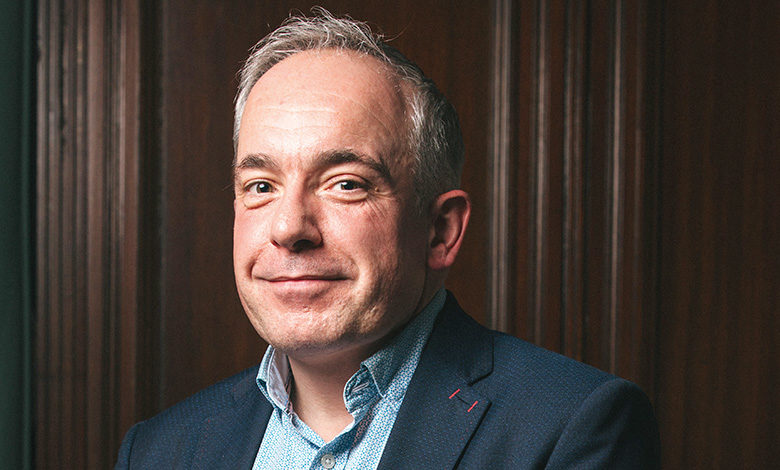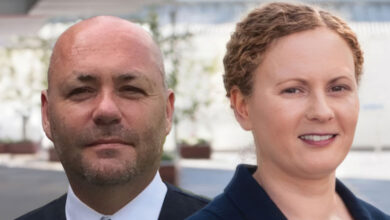A future network for all

Managing Director Derek Hynes outlines the role of NIE Networks in creating a more investible and decarbonised Northern Ireland, as the organisation prepares to submit its ambitious price control plan (RP7) out to 2031.
Hynes is clear in his belief that the Regulatory Period 7 (2025-2031) will be a critical step in enabling the transformation of the electricity network necessary to facilitate a net zero carbon future.
NIE Networks recently concluded public consultation on the plan which seeks to double investment levels in the network to £2.6 billion, and Hynes acknowledges the “responsibility” that comes with such an ambitious investment plan, set to be submitted to the Utility Regulator in March 2023.
Underpinning the need for transformation is the Department for the Economy’s Pathway to Net Zero strategy and the subsequent Climate Change Act, which commits to a target of 80 per cent of electricity consumption coming from renewable sources by 2030, and to net zero carbon emissions by 2050.
Although full decarbonisation will require a range of renewable technologies, electrification has been identified as a key driver across energy, heat and transport. As the owner of an electricity network consisting of approximately 2,200km of transmission network and 47,000km of distribution network, NIE Networks’ reach to over 910,000 customers in the form of homes, businesses, and farms, means that the capacity, accessibility, and reliability of its network is critical.
The Managing Director explains that to meet demand, NIE Networks is embarking on the most significant change in design, management, and operation of the electricity network since rural electrification in the 1960s.
“By delivering an innovative, dynamic, and integrated distribution system that can flex in response to supply and demand, our customers will benefit from faster and cheaper access to network capacity.”
Derek Hynes, Managing Director, NIE Networks
“Our vision is to provide an electricity network that is capable of facilitating Northern Ireland’s overall plan to address climate change, which aims to achieve net zero carbon and affordable energy by ending our society’s reliance on fossil fuels and its associated price volatility,” Hynes states.
However, he stresses that NIE Networks is aware of the responsibility it has to strike a balanced position in its future plans, ensuring that not only is investment in the electricity network maximised, but that such investment does not add to the financial hardship currently being felt by many customers.
Capacity
Identifying two major shifts in recent years, in the form of not only a consumer-led societal shift, based on morality, ethics and climate justice, but also a manufacturing-led revolution which will ultimately see the removal of fossil-fuel powered heating and transport, Hynes emphasises that lack of capacity on Northern Ireland’s 100-year-old electricity network must not act as a blocker to transformation.
Forecasts carried out by NIE Networks estimate that by 2030, Northern Ireland’s electricity network will need to support 80 per cent of clean energy generation and facilitate around 300,000 electric vehicles and 120,000 heat pumps.
Offering context to the challenges to network capacity such a shift would pose, Hynes says that the network currently supports around 770,000 homes with instantaneous consumption of around 2.5kW per home. However, it is estimated that with the introduction of an electric vehicle and a heatpump, the average household consumption will rise to 7kW per home, exceeding the expectation of the planning, engineering and design standards which have existed since the 1950s.
“There is no doubt in my mind that there is not enough spare capacity in the existing network to allow that level of increase,” states Hynes.
The Managing Director says that underpinning the scale of the transformation needed is the relatively low level of additional long-term capacity investment through the RP4 and RP5 price control periods. While the current RP6 has progressed in building in additional network capacity, particularly replacing elements of the 11KV overhead line network which feeds the vast majority of towns and villages, RP7 is significantly more ambitious.
He explains: “RP6 has been a good period for connecting generation to the network, with about 1.8GW of generation connected to the distribution system in Northern Ireland. However, what that has done is use up any spare headroom on the transmission and distribution systems.
“RP6 has been a good period for connecting generation to the network, with about 1.8GW of generation connected to the distribution system in Northern Ireland. However, what that has done is use up any spare headroom on the transmission and distribution systems.”
“Electrification only makes sense environmentally if consumption is from a renewable, non-fossil fuel based, and locally produced generation source, so we must build the electricity network to allow those sources to be connected.
“By delivering an innovative, dynamic, and integrated distribution system that can flex in response to supply and demand, our customers will benefit from faster and cheaper access to network capacity. This will also enable uptake of low-carbon technologies at least cost, whilst retaining flexibility in the network for future changes in customer demands.”
RP7
Plans to almost double the level of investment through RP7, compared to planned expenditure in RP6 (£1.4 billion), will mean an extra £1.2 billion over the seven-year period. Hynes sets out that £800 million is earmarked for replacing old network, including increasing capacity in the low voltage urban network.
This, he explains, will see almost all the older 3-5kVA pole mounted transformers on the network replaced with a new standard of 25kVA transformers and the Managing Director believes that by proactively and efficiently rolling out these upgrades, NIE Networks can mitigate connection delays and barriers for customers wanting to decarbonise their homes.
Additionally, investment in reliability will see around £400 million go towards replacing a range of many high-voltage substations. Many of these have passed the end of their economic life of between 40 to 50 years and are now also reaching the end of their technical life, leading to a reduction in reliability and increase in maintenance costs.
Beyond the network itself, Hynes points to plans to increase investment in NIE Networks’ IT spend by four times what it has been in the past, enabling amongst other things a greater emphasis on digital engagement with its customers, as well as the integration of improved monitoring technology and the utilisation of the data capabilities that come with it.
A number of major initiatives still sit outside the RP7 plan, awaiting policy direction from the Department for the Economy, including smart metering, the North South Interconnector, connections policy, and the facilitation of offshore generation. While inclusion of these policies would require further investment, Hynes acknowledges that within the time period of RP7, NIE Networks must build in flexibility to enable future policy direction and foresight. This will lay the groundwork for RP8 and RP9, which will bring Northern Ireland to almost 2050, if the electricity network is to support a decarbonised future.
Hynes emphasises the importance of strong policy direction as NIE Networks seeks to raise private investment. The company receive a small percentage of a customer’s overall energy bill and profit generated from this source enables it to raise debt to fund its investments in the electricity network in Northern Ireland.
NIE Networks is in an advantageous position in this regard, with large investor interest in regulated energy companies, as a model which provides a large degree of certainty for return on investment. Equally, NIE Networks, as a business with a central role in delivering a net zero agenda for a whole region, is recognised as sustainable and green investment by many banks and investors.
However, Hynes acknowledges that some challenges exist to attracting investment. While political stability in Northern Ireland helps to make it more attractive to investors, more important, he emphasises, is that clear energy and environmental policy direction is issued in a timely manner, enabling the right price signals to the market.
“The bulk of our investment is in long-life assets so, while the overall cost is significant, the charges levied on customers to pay for those assets are spread over a long time period, meaning the annual cost will be much smaller.”
“The private sector has a profit motive and, given the appropriate regulatory price signals, has trust in our regulated model. However, they also require certainty in the direction that Northern Ireland and NIE Networks are going. NIE Networks has been well supported by the Utility Regulator in recent years, particularly in the two years post-Covid, where investment has been enabled in the right areas. In this regard, the RP6 period has been a steppingstone from a maintenance level of network investment to a network growth investment level over the last few years of RP6. RP7 can be a major enabler of transformation of the network.”
Another interest of investors is not just NIE Networks’ role in decarbonisation, but the green credentials of the company itself. Hynes believes NIE Networks’ Environmental Action Plan commitments for the RP7 period are “ambitious and achievable”.
Commitments for 2030 include the halving of directly controllable carbon emission; electrification of more than half of the company’s fleet; and the promotion of environmental and social transparency in the company’s supply chain.
Internal capacity is also a priority. RP7 includes an ambition for NIE Networks to increase its current headcount of 1,400 to more than 2,000 by 2030 with most of those new jobs appearing by 2028. In addition to recruiting for roles including IT, finance, data analysts, technical and skilled staff, NIE Networks is already building on its apprenticeship, trainee and graduate programmes. In January 2023, NIE Networks will begin recruitment for 27 apprentices and Hynes outlines that this will rise to closer to 100 from 2025.
“Our apprenticeship scheme is a vital talent pipeline for the company and will be essential in transforming the network for the benefit of NI plc for the next seven years and beyond,” he says.
Customer
In April 2021, NIE Networks published its strategy paper titled Networks for Net Zero, setting out its views on how electrification can play a key role in a flexible and integrated decarbonised energy system. It reinforced NIE Networks’ ambition to place customers at the forefront of the energy transition by minimising future network costs in the delivery of a low carbon economy and providing flexibility in the network to enable customers to make informed decisions on energy efficiency and opportunities for active participation in new markets.
To deliver, NIE Networks is transitioning to a Distribution System Operator (DSO), which Hynes explains will see the organisation “focused on delivering whole system and customer benefits through the facilitation of access to markets and minimising future network costs in the delivery of a low carbon economy”.
Despite ambitions to double levels of investment in the network over the RP7 period, Hynes is quick to point out that the amount paid by the consumer to NIE Networks is unlikely to rise above RP6 levels due to greater levels of electricity consumption.
He adds: “The bulk of our investment is in long-life assets so, while the overall cost is significant, the charges levied on customers to pay for those assets are spread over a long time period, meaning the annual cost will be much smaller.
“We estimate that the volume of electricity transported across our network will, on average, be around 10 per cent higher during RP7 compared to average levels in RP6 as electricity replaces fossil fuel usage. This will put downward pressure on average network charges, which means we estimate we can deliver the increased levels of investment during RP7 whilst keeping distribution network unit charges (in real terms) in line with those of RP6.”
Summarising his vision for the RP7 plan, Hynes reiterates his belief that NIE Networks has a key role in facilitating the delivery of a sustainable energy system for all.
He concludes: “This level of change cannot be delivered alone. We need a collective, collaborative approach across government and industry. We need politicians and communities to buy in to the bold and highly ambitious vision.
“We need support from leading industry figures, academia and entrepreneurs to deliver the step change our economy needs and create a more investible Northern Ireland.”






